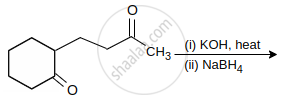Advertisements
Advertisements
प्रश्न
Which of the following compounds would undergo aldol condensation, which the Cannizzaro reaction and which neither? Write the structures of the expected products of aldol condensation and Cannizzaro reaction.
- Methanal
- 2-Methylpentanal
- Benzaldehyde
- Benzophenone
- Cyclohexanone
- 1-Phenylpropanone
- Phenylacetaldehyde
- Butan-1-ol
- 2, 2-Dimethylbutanal
उत्तर
Aldehydes and ketones having at least one α-hydrogen undergo aldol condensation.
The compounds (ii) 2-Methylpentanal, (v) Cyclohexanone, (vi) 1-phenylpropanone, and (vii) Phenylacetaldehyde contain one or more α-hydrogen atoms. Therefore, these undergo aldol condensation.
Aldehydes having no α-hydrogen atoms undergo Cannizzaro reactions. The compounds (i) Methanal, (iii) Benzaldehyde, and (ix) 2, 2-dimethylbutanal do not have any α-hydrogen. Therefore, these undergo cannizzaro reactions.
Compound (iv) Benzophenone is a ketone having no α-hydrogen atom and compound (viii) Butan-1-ol is an alcohol. Hence, these compounds do not undergo either aldol condensation or cannizzaro reactions.
Aldol condensation:
(ii)
\[\begin{array}{cc}
\phantom{...................................................}\ce{CH3}\\
\phantom{................................................}|\\
\ce{2CH3CH2CH2 - CH - CHO ->[dil NaOH] CH3CH2CH2 - CH - CH - CH - CH2CH2CH3}\\
|\phantom{...................................}|\phantom{......}|\phantom{......}|\phantom{}\\
\phantom{......}\ce{\underset{2-Methylpentanal}{CH3}}\phantom{....................}\ce{\underset{3-Hydroxy-2,4-dimethyl-2-propylheptanal}{\phantom{..}CH3\phantom{...}OH\phantom{...}CHO}}
\end{array}\]
(v)

(vi)

(vii)

Cannizzaro reaction:
(i)
\[\begin{array}{cc}
\ce{H}\phantom{..............................}\ce{H}\phantom{.......}\ce{H}\phantom{......}\\
\backslash\phantom{..............................}|\phantom{.........}\backslash\phantom{....}\\
\ce{2\phantom{...}C = O + conc.KOH -> H - C - OH + C - OK}\\
/\phantom{..............................}|\phantom{.........}/\phantom{....}\\
\ce{\underset{Methanal}{H}}\phantom{..........................}\ce{\underset{Methanol}{H}}\phantom{.}\ce{\underset{methanoate}{\underset{Potassim}{H}}}\phantom{......}
\end{array}\]
(iii)

(ix)
\[\begin{array}{cc}
\phantom{.....}\ce{CH3}\phantom{............................}\ce{CH3}\phantom{........................}\ce{CH3}\phantom{...}\\
\phantom{}|\phantom{...............................}|\phantom{............................}|\phantom{.}\\
\ce{CH3CH2 - C - CHO ->[conc. NaOH] CH3CH2 - C - CH2 - OH + CH3CH2 - C - C - ONa}\\
\phantom{.....}|\phantom{...............................}|\phantom{............................}|\phantom{....}||\phantom{}\\
\phantom{.........}\ce{\underset{2, 2-Dimethylbutanal}{CH3}}\phantom{...............}\ce{\underset{2, 2-Dimethylbutan-1-ol}{CH3}}\phantom{..........}\ce{\underset{Sodium 2, 2-dimethylbutanoate}{CH3\phantom{.}O}}\phantom{.}
\end{array}\]
APPEARS IN
संबंधित प्रश्न
What is meant by the following term? Give an example of the reaction in the following case.
Aldol
Describe the following:
Cross aldol condensation
Complete the synthesis by giving missing starting material, reagent or product.
\[\begin{array}{cc}
\ce{C6H5CHO}\phantom{............}\\
\phantom{........}\ce{+\phantom{......}\ce{->[dil.NaOH][\Delta]}}\phantom{...}\\
\ce{CH3CH2CHO}\phantom{............}
\end{array}\]
Give reasons Acetylation of aniline reduces its activation effect.
Cannizaro’s reaction is not given by ______.
Which product is formed when the compound  is treated with concentrated aqueous \[\ce{KOH}\] solution?
is treated with concentrated aqueous \[\ce{KOH}\] solution?
Which of the following conversions can be carried out by Clemmensen Reduction?
(i) Benzaldehyde into benzyl alcohol
(ii) Cyclohexanone into cyclohexane
(iii) Benzoyl chloride into benzaldehyde
(iv) Benzophenone into diphenyl methane
What product will be formed on reaction of propanal with 2-methylpropanal in the presence of \[\ce{NaOH}\]? What products will be formed? Write the name of the reaction also.
Why are carboxylic acids more acidic than alcohols or phenols although all of them have hydrogen atom attached to a oxygen atom \[\ce{(-O-H)}\]?
Assertion: The α-hydrogen atom in carbonyl compounds is less acidic.
Reason: The anion formed after the loss of α-hydrogen atom is resonance stabilised.
Assertion: Aromatic aldehydes and formaldehyde undergo Cannizaro reaction.
Reason: Aromatic aldehydes are almost as reactive as formaldehyde.
When liquid ‘A’ is treated with a freshly prepared ammoniacal silver nitrate solution, it gives bright silver mirror. The liquid forms a white crystalline solid on treatment with sodium hydrogensulphite. Liquid ‘B’ also forms a white crystalline solid with sodium hydrogensulphite but it does not give test with ammoniacal silver nitrate. Which of the two liquids is aldehyde? Write the chemical equations of these reactions also.
Cross aldol condensation occurs between
Identify A and B from the following reaction:
\[\begin{array}{cc}
\ce{CH3}\phantom{.................}\\
|\phantom{....................}\\
\phantom{}\ce{2CH3 - C = O ->[Ba(OH)2] A ->[Δ] B + H2O}
\end{array}\]
Convert the following:
Acetaldehyde to But-2-enal
\[\ce{CH3-CH2-CHO ->[dil][alkali] Product}\]
The product in the above reaction is:
The major product of the following reaction is:

Which of the following does not give aldol condensation reaction?
When acetaldehyde is treated with dilute NaOH, the following reaction is observed.
\[\begin{array}{cc}
\ce{2CH3 - CHO ->[dil.NaOH] CH3 - CH - CH2 - CHO}\\
\phantom{...............}|\\
\phantom{.................}\ce{OH}
\end{array}\]
- What are the functional groups in the product?
- Can another product be formed during the same reaction? (Deduce the answer by doing atomic audit of reactant and product).
- Is this an addition reaction or condensation reaction?
